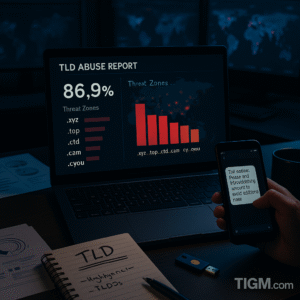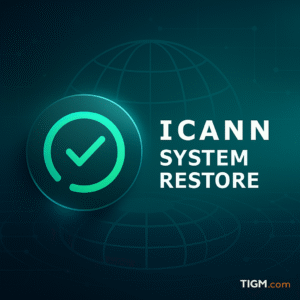Major outages at Cloudflare and AWS within the past month exposed a fundamental weakness in internet infrastructure — extreme centralization that turns single technical errors into global digital blackouts.
When Cloudflare went down for several hours on November 18, 2025, it took X, ChatGPT, Spotify, Shopify, and hundreds of other services offline. Just weeks earlier, AWS’s US-EAST-1 region failure crippled over 3,500 companies across 60 countries.
For domain investors, registrars, and anyone running digital infrastructure, these incidents underscore an uncomfortable reality: the modern internet depends on a handful of providers whose failures cascade instantly.
The Concentration Problem
AWS, Microsoft Azure, and Google Cloud collectively control roughly two-thirds of the global cloud market. Cloudflare alone acts as a traffic accelerator and security shield for an estimated 20% of the internet.
That consolidation creates systemic risk. A configuration error in one Virginia data center (AWS US-EAST-1) or a faulty machine learning feature file at Cloudflare doesn’t stay localized — it ripples across continents, industries, and entire service categories.
Professor Alan Woodward of the University of Surrey put it bluntly: the outages demonstrated how “very important Internet-based services are reliant on a relatively few major players,” meaning their failures never remain isolated.
What Went Wrong
Cloudflare’s November 18 outage stemmed from an automatically generated configuration file for its Bot Management system. The file grew beyond expected size, crashed the traffic management system, and triggered widespread 500 errors across the network for nearly three hours.
The AWS outage in October originated from a DNS resolution failure in US-EAST-1, the company’s largest and most critical region. Services including Vanguard, Robinhood, Microsoft Teams, Roblox, and Fortnite went dark. Estimated damages exceeded $75 million per hour.
Neither outage involved cyberattacks — both were internal technical errors. But the impact was global, immediate, and costly.
Domain Infrastructure Implications
For domain investors and registrars, these outages reveal specific vulnerabilities:
DNS infrastructure often relies on cloud-hosted nameservers. When AWS or Cloudflare experience network disruptions, DNS resolution can fail even if domains are properly configured.
Domain marketplaces, broker platforms, and auction systems built on single-cloud architectures face complete downtime when that provider fails.
WHOIS services, EPP systems, and registry connections depend on reliable network paths. Cloudflare’s role as a CDN and DDoS protection layer means outages can block access to critical registrar and registry APIs.
The concentration risk extends to domain parking, analytics platforms, and automated pricing tools — most run on AWS, Google Cloud, or Azure infrastructure.
The Multi-Cloud Illusion
Many companies claim to run “multi-cloud” strategies, but true redundancy requires more than deploying workloads across multiple providers.
Applications need architecture designed to fail over seamlessly when one provider goes down. That means duplicate databases, load balancers that reroute traffic automatically, and DNS configurations that switch between providers without manual intervention.
Most organizations don’t have that level of redundancy because it’s expensive, complex, and rarely tested. So when Cloudflare or AWS fails, multi-cloud strategies often collapse into single points of failure anyway.
What Registrars and Domain Businesses Can Do
Monica Eaton, CEO of Chargebacks911, argues businesses need to treat outages as routine operational risks, not rare anomalies.
Her advice: Track failed transactions. Communicate with customers before they start guessing what went wrong. Document what happened immediately so you’re not piecing it together weeks later when chargebacks arrive.
For domain businesses specifically:
- Use multiple DNS providers with automatic failover configured at the authoritative nameserver level
- Host critical APIs and transaction systems across geographically distributed regions, not just different availability zones within one provider
- Maintain offline backups of domain inventory, pricing data, and customer records
- Test failover procedures regularly — most redundancy fails because it’s never actually used until an emergency
The Broader Internet Architecture Question
These outages are accelerating interest in decentralized infrastructure. Web3 advocates point to solutions like IPFS-based storage, Filecoin networks, and decentralized CDNs as alternatives that eliminate single points of failure.
Governments are also stepping in. The UK announced a national outage-response plan after Cloudflare’s disruption affected retail payments and Visa transactions.
But the reality is stark: the threats that Cloudflare, AWS, and Azure protect against — massive DDoS attacks, global traffic distribution, instant scaling — require infrastructure that only a handful of companies possess.
As Jake Moore of ESET noted, companies don’t choose to rely on these providers out of convenience. They do it “because there aren’t many other options” at the scale required for global operations.
The Takeaway
When Cloudflare sneezes, half the internet catches a cold. When AWS stumbles, thousands of services fall.
Domain businesses can’t eliminate that risk entirely, but they can architect systems to survive it. The alternative is watching revenue vanish for hours while waiting for a third-party provider to restore service.
Redundancy isn’t cheap. But neither is explaining to customers why their domain transactions failed because a configuration file at Cloudflare grew too large.
Related reads : Google Wins NanoBananaAI.com Dispute After Panel Reverses Earlier UDRP Outcome








